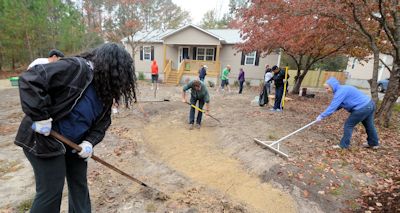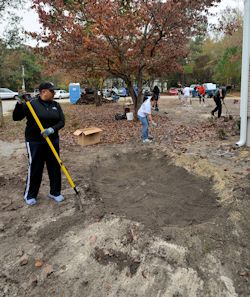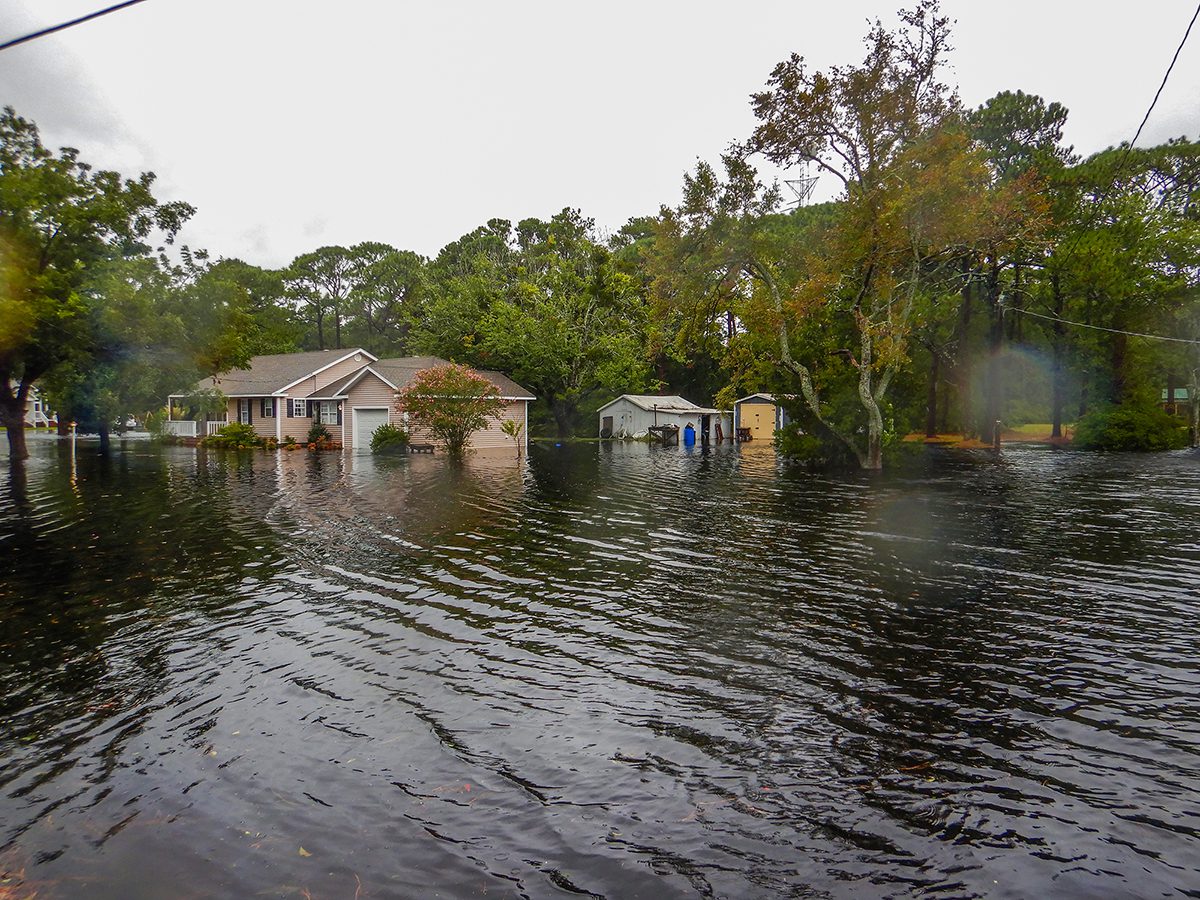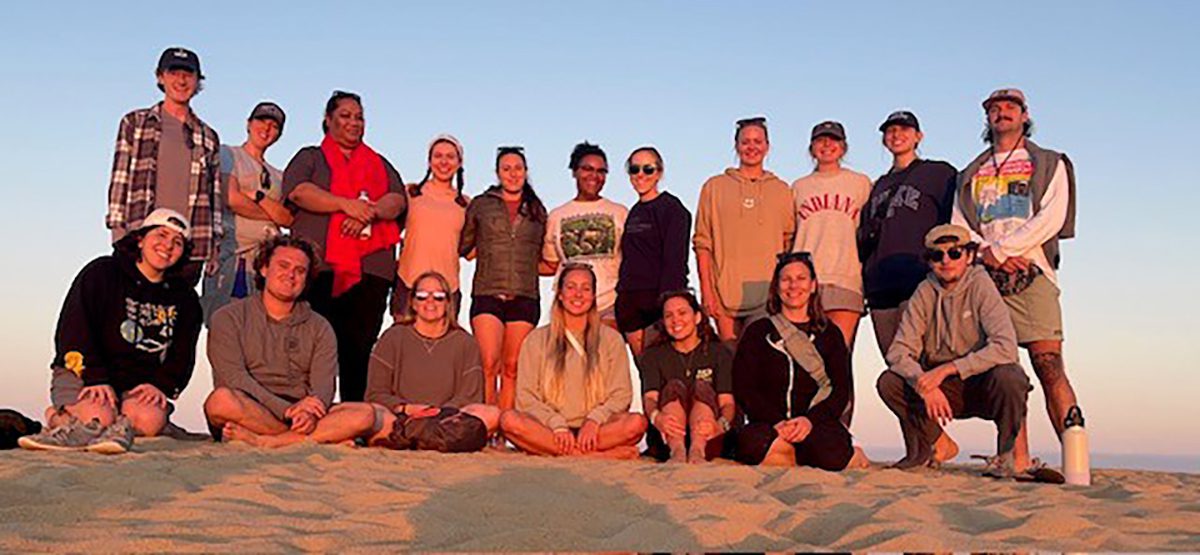
Volunteers start creating a rain garden in front of the Habitat for Humanity house. |
LELAND – A little rain didn’t keep volunteers from helping the Alvarez family plant native plants and build rain gardens at their new Habitat for Humanity home. Not only did it ease landscaping by softening the soil, but the rain was symbolic of what the volunteers were doing: Helping to preserve and restore a river by reducing the amount of polluted runoff that flowed into it.
Sponsor Spotlight
Native plants and rain gardens are just two of the simple and inexpensive stormwater management techniques known as low-impact development, or LID. As a part of their ongoing work in Brunswick County to help restore the Lockwoods Folly watershed, the N.C. Coastal Federation partnered with Brunswick Habitat for Humanity to retrofit and implement LID designs at two housing projects.
“We want to work with all different types of groups to show that LID can be done anywhere, on small residential houses up to commercial buildings,” said Lauren Kolodij, deputy director of the federation.
Habitat for Humanity is a non-denominational Christian organization with a vision for a world where everyone has a decent and affordable place to live. Founded locally in 1994, the Brunswick affiliate has built over 40 homes for families with small children, single parents and the disabled. Homes are built by volunteers using tax-deductible donations and sold to families with no-interest loans. Homeowners not only help build their own house but the homes of others before every receiving the key to their front door.
 Sponsor SpotlightVeronica Carter and homeowner Jose Alvarez are all smiles after a hard day’s work. |

Another depression that will become a rain garden starts to take shape. |
“I like the idea that the homeowners are involved. They have to put some sweat equity in it; they have to qualify and pay the mortgage. So it’s a hand-up rather than a hand-out,” said volunteer Al Hight, New Hanover county extension director for the N.C. Cooperative Extension.
Over a dozen volunteers showed up last month to show their support and do their goodwill under the wet weather. The group included students from the University of North Carolina-Wilmington, volunteers from Habitat for Humanity and the federation, members of the New Hanover and Brunswick counties Cooperative Extension offices, the Coast Guard and experts on plants and landscaping techniques in the region.
“I think it’s important to always give something back,” said Hight, who has worked for the extension for the last 10 years. He was also a landscape contractor and “an old farm boy” in another life, he says.
“A lot of time it’s stuff that I know how to do a lot better than some other people know how to do, so I feel like it’s imperative that I help out, you know?” he said.
Veronica Carter, who serves on the board of both Brunswick Habitat for Humanity and the federation, rallied the group of volunteers. “We want to help people when they get affordable houses, like the Alvarezes will hopefully get in a few days now, be able to sustain their neighborhood and the aquifers and themselves because they’re going to be able to reuse some of the rainwater that we collect here today.”
Rainwater harvesting systems, like a rain barrel or cistern, can be used to collect stormwater from a downspout and use later to water the garden. Using native plants is another LID technique. Native plants require less effort to grow and less money to maintain because they’re conditioned to living in the coastal environment, unlike ornamental, nonnatives that may require fertilizers and heavy irrigation.
Directing volunteers on Habitat’s behalf was Linda Rudick, the volunteer landscape coordinator for the last 10 years. “I consider the landscape as the jewelry to finish the Habitat house,” Rudick said.
Since undertaking the LID project, she’s widened the scope of her landscaping to include native plants and rain gardens.
A rain garden is a depressed area that acts as a bowl collecting stormwater from the areas of higher elevation in the yard. Rain gardens can reduce polluted runoff from a site by 90 percent or more. Plants in a rain garden not only use the water to grow, but their roots create resistance to the flow, prevent erosion and aerate the soil for draining water.
The U.S. Environmental Protection Agency in 2007 funded a three-year study in the watershed that revealed the need to reduce the flow of stormwater from all land contributing to surface runoff. Specifically, 94 percent of developed land in the watershed needed to be targeted for stormwater retrofits.
“The only way to protect and restore coastal water quality is to maintain or mimic the natural hydrology. And the only way to really accomplish that is to deal with stormwater on a lot-by-lot basis,” said Kolodij.

Native plants will help absorb stormwater. |
The N.C. Cooperative Extension has been working with the federation for the last decade on the Lockwoods Folly Watershed restoration project. The two groups have similar goals, Hight said.
“As far as trying to do things that help us clean up surface waters, keep our environment in good shape so that we can keep a healthy population and healthy wildlife and good tourism,” he said.
An EPA grant paid for the LID project and partnership with Habitat for Humanity. The federation hopes that it will serve as a model for future Habitat housing projects and demonstrate to the community that LID techniques can be affordable for any and all homeowners.
“We’re going to use this blueprint to give to Habitat and say, ‘Guys, incorporate this in the rest of what you do,’” said Carter.
Dee Antonio, executive director of Brunswick Habitat for Humanity, said she hoped to continue using LID in other projects. However, the labor required to build rain gardens will depend on volunteers, she said.
“Most of our volunteers are retired people in their 60s and some of them into their 70s so I think we’ll struggle each time we have a project to be able to find folks to do those basins,” Antonio said.







